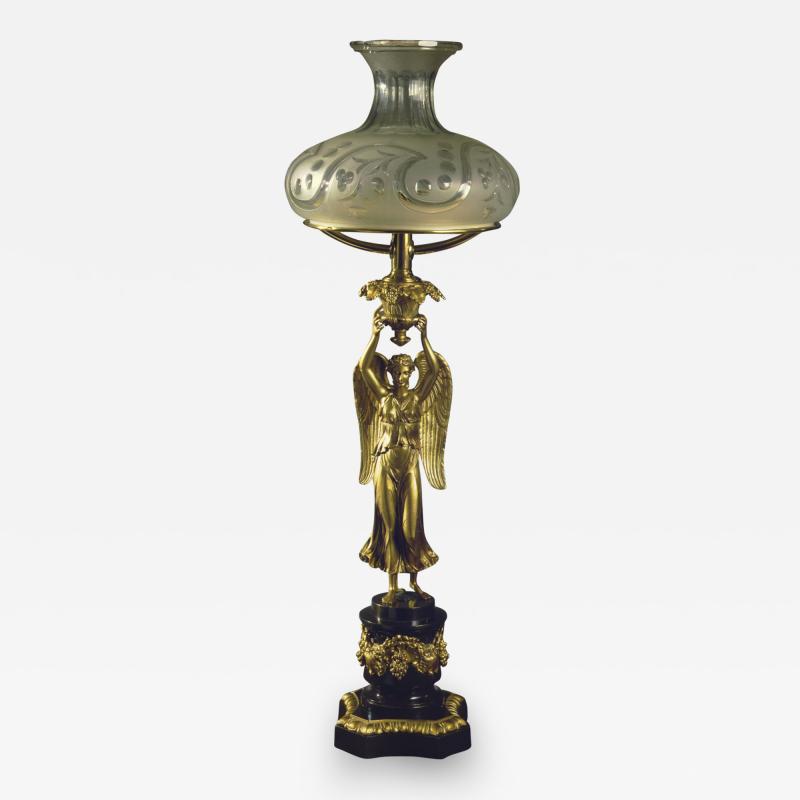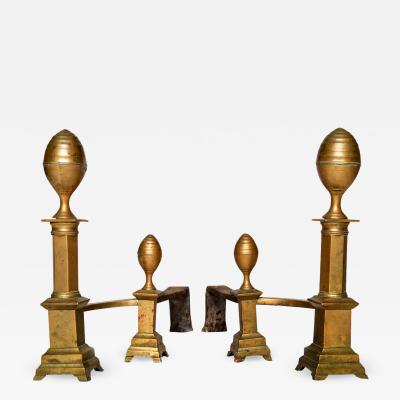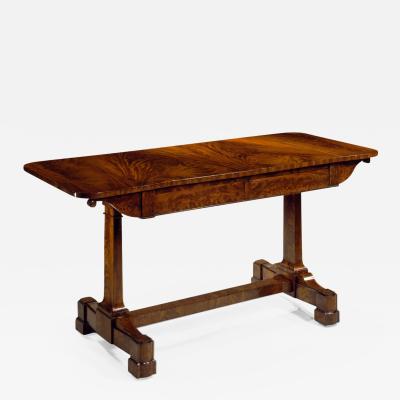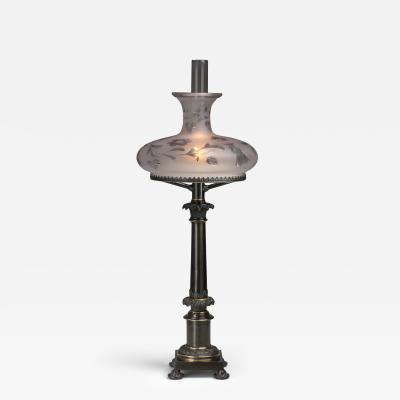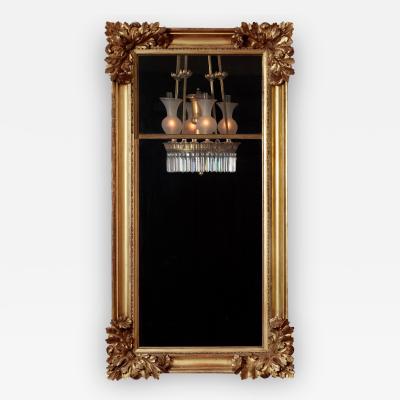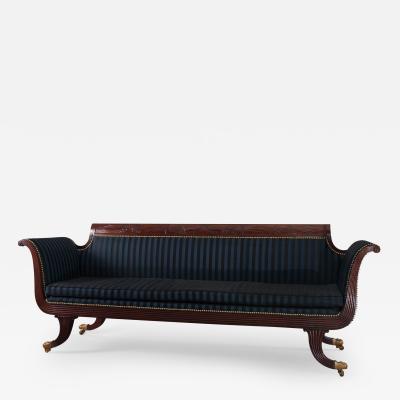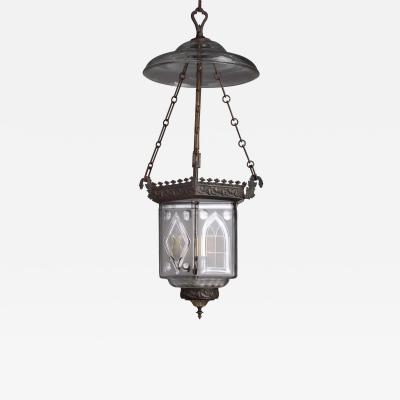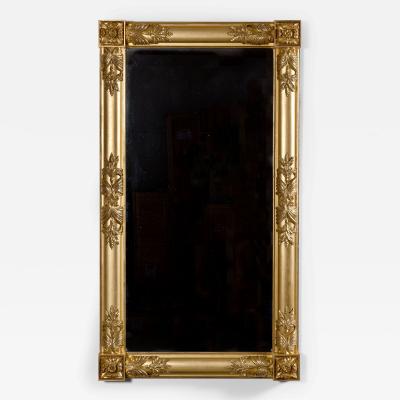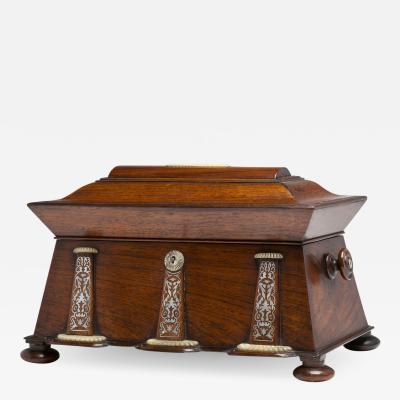Listings / Furniture / Lighting / Table Lamps
Lacquered Brass Sinumbra Lamp with the Goddess Nike
-
Description
IMPORTANT MATTE, BURNISHED AND PATINATED LACQUERED BRASS
FIGURAL SINUMBRA LAMP WITH NIKE, GREEK GODDESS OF VICTORY
Thomas Messenger & Sons
Birmingham, England 1932-1840
Henry N. Hooper & Co., Boston (active 1832-1868) wholesaler
The blown and cut glass shade on a flattened doughnut-shaped font held above a figure of winged Nike, goddess of victory, on a stepped cylindrical pedestal base decorated with swags and garlands on a molded polygonal base.
H: 37 ¼”
Condition: Excellent; The matte and burnished lacquered surface has been restored to its original appearance, electrified.
This monumental example was retailed by Henry N. Hooper & Co., Boston (active 1832-1868) and it appears as item no.176 in the 1850 Hooper catalogue; the earliest catalogue from this company that is known, although, presumably, an earlier catalogue was produced. Hooper refers to the “faux-d’oré” surface, developed to simulate mercury gilding, as “or-molu.” Hooper’s factory was on Causeway Street and their store at 24 Commercial Street. Although Hooper was a manufacturer of brass lighting as well as supplying a broad range of copper and brass products, this model was an import, private labeled by Messenger.
A “sinumbra” lamp works on the Argand burner principal but the font or oil reserve is in the shape of a flattened doughnut, allowing light to stream directly out and down through the hole onto a table without the font blocking light and casting a shadow, hence “without shade.” Sinumbras that have a shade that sits on the outside rim of the font obscuring it, are known as Isis lamps.
Figural Sinumbra lamps are rare and ones of this scale are rarer still. This is the finest example of a Sinumbra lamp that we have ever seen.
Geneva-born philosopher and inventor Francois-Pierre-Ami Argand (1750-1803), finally received a British patent for his lamps developed a few years earlier in Paris on March 15th, 1784 (patent no. 1425). His invention which promised "a lamp that is so constructed to produce neither smoak [sic.] nor smell, and to give considerably more light than any lamp hitherto known" consisted of a tubular wick held between metal tubes, a rack and pinion wick riser assembly and a tall, narrow chimney that fit closely around the wick causing air to be drawn up through the center of the flame as well as around its outside creating more thorough combustion. It was designed to burn rape-seed (colza) and whale oil, issuing from an oil reserve or “font” positioned so that the oil would flow from the force of gravity to the burner.
This invention, developed initially with Matthew Bolton and James Watt in England, was subsequently manufactured by a host of makers in Birmingham including Messenger, Johnston-Brookes, Phipson & Lambley, Fletcher & Day and J. & C. Ratcliff. Hailed by Rees in his encyclopedia of 1819 The Universal Dictionary of Arts, Sciences, and Literature saying "it may be justly ranked among the greatest discoveries of the age" and by Benjamin Franklin who noted it was "much admired for its splendor," Argand's invention was the most important advancement in home lighting since the discovery of fire.
Messenger was among the largest and most successful of the many manufacturers of lighting based in Birmingham, England, who exported their products to the United States. First appearing in the Birmingham directory as Messenger and Phipson in 1797, the firm survived into the twentieth century. Virtually all oil lamps in America prior to 1830 were imported from England and sold through retailers in the major cities on the Northeast seaboard.
Several American manufactures began making Argand lamps in the 1830's including Henry N. Hooper and William Carleton in Boston, Starr, Fellows and The Dietz Company in New York and Cornelius in Philadelphia. -
More Information
Documentation: Signed Origin: England Period: 19th Century Materials: lacquered brass Condition: Excellent. electrified Creation Date: c. 1830 Styles / Movements: Classical, Regency, Neoclassical Dealer Reference #: L-012174 Incollect Reference #: 202808 -
Dimensions
H. 37.25 in; H. 94.62 cm;
Message from Seller:
Welcome to Carswell Rush Berlin Antiques, a premier New York City-based dealer specializing in American antique furniture and decorative accessories from the Classical period (1800-1840). For inquiries, please contact us at 646.645.0404 or email carswellberlin@msn.com.















